 Facebook
Facebook
 X
X
 Instagram
Instagram
 TikTok
TikTok
 Youtube
Youtube
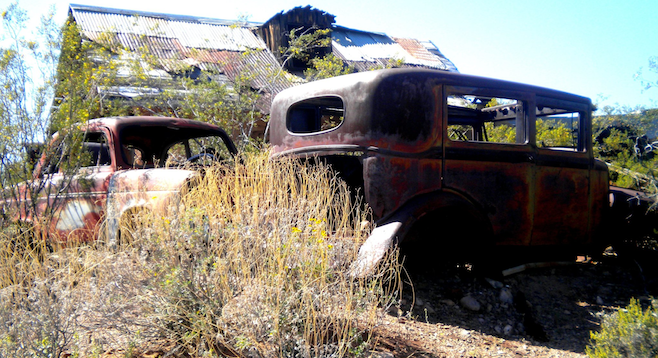
There is no denying it; I am an apocalyte. A lover of all things bleak and transient, the beauty of decay is in my blood. Find me a ghost town, a derelict asylum, an abandoned power station or even an empty barn and I’m happy.
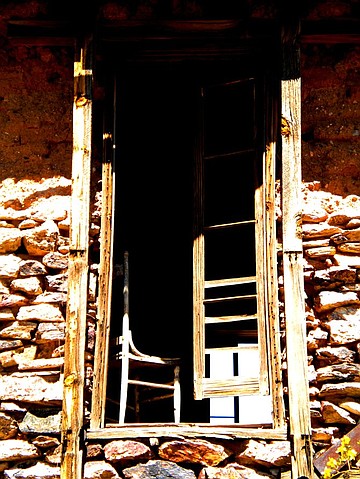
So, on a trip through Arizona to visit the Grand Canyon and trippy little Sedona, it was inevitable that Vulture City would catch my eye. A few miles west of Wickenburg, the now-defunct gold mine was established in the 1860s (by Henry Wickenburg himself) and, despite flourishing into a thriving settlement, closed down less than a century later after national focus shifted to the war effort.
Now, the mine and town lie barren at the mercy of the harsh, desert winds. And for just a $10 entry fee, we were given a hand-drawn "treasure map" and free run of the place.
A small disclaimer: I was lucky enough to visit Vulture Mine before new ownership took over and restricted visitors to guided tours, which is an absolute shame. Surely the allure of any ghost town is the chance to step away from the crowds and imagine you’re the only person exploring the lonely structures, a last, surviving observer of the past? Such opinions aside, Vulture City is still worth a stop (but best check the opening times first).
The remains of the town and mine are surprisingly well-preserved, and it's an easy mile-or-so wander to see everything.
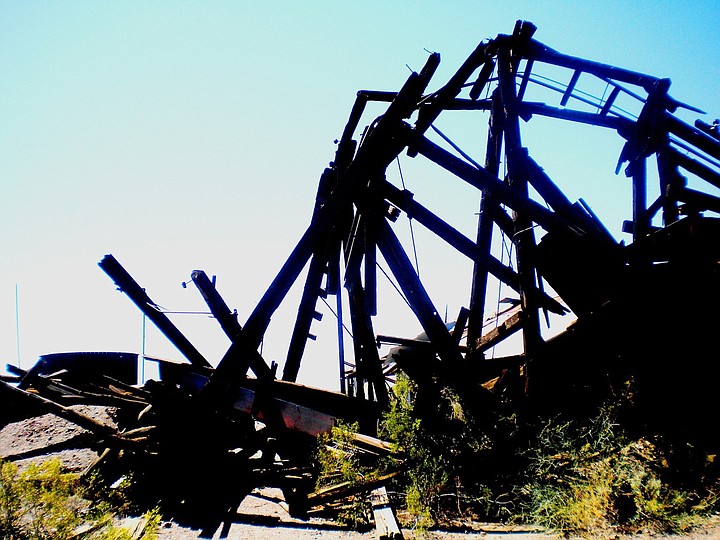
Mining offices and buildings are fenced-off to protect the crumbling history, but there are enough open areas to explore firsthand. The rickety wooden mine headframe (left) towers like a prehistoric rollercoaster over a shabby blacksmith shop decorated with tools and disembodied miner’s boots. The tin sidings gleamed with bullet holes. A suspended plank of wood twirled and creaked eerily in the breeze. A previous explorer had scrawled "redrum" on a dusty window pane, but even creepier were the suspended grubby long-johns, swaying from a hook like a ghostly miner warning us away. Even on a blistering bright day, something about Vulture City brings out the chills.
To the ghost town enthusiast, the interesting combination of history and setup can feel staged in places – rusting bathtubs, a high-heeled shoe standing proud in the window of the cathouse, sewing machines and antique furniture posed in flaking doorways – but most of it has a genuine feel.
The kitchen built to feed the miners stills stands, with shelves of mismatched crockery and peeling cans of food and coffee. The buildings do not look reconstructed or patched up, they're original pieces of a short-lived yet crucial part of American history (even if they do look as if they would fall over at any moment).
The added personal touches may seem phony in places, but they do give an authentic sense of the people who lived, worked and died here.
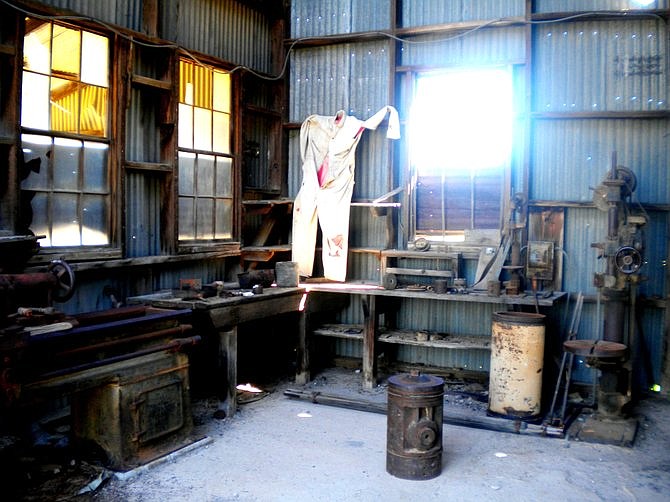
Another must-see is the mill where heavy chunks of gold ore were crushed through a minefield of rusting jaws and wheels to release the precious commodity. Iron oxide bleeds through the bolts and cogs, giving them the gory appearance of ancient mangled insides. The eviscerated electronics and pressure gauges make for truly great photos, and we clambered over the machinery to get the best angled shots.
The adjacent storage room of discarded cyanide containers was especially photogenic - presumably the noxious poison was used to leach gold from the ore – with upturned barrels oozing suspicious white residue like a scene from an ecological disaster movie. Probably best to wash our hands before leaving town.
A particularly sinister point of interest is the Hanging Tree. Eighteen men accused of theft were allegedly executed from the low-hanging branches (a nasty way of prolonging the torture of death, with a reprieve being just a tiptoe out of reach).
We ate our Subway sandwiches under the boughs, and I have to admit, there was nothing even remotely spooky about the experience. Perhaps it was the glorious sunshine or chatter of cheeky birds in the trees that lightened the menacing surroundings, but it felt peaceful compared to the industrial malevolence of the mill.
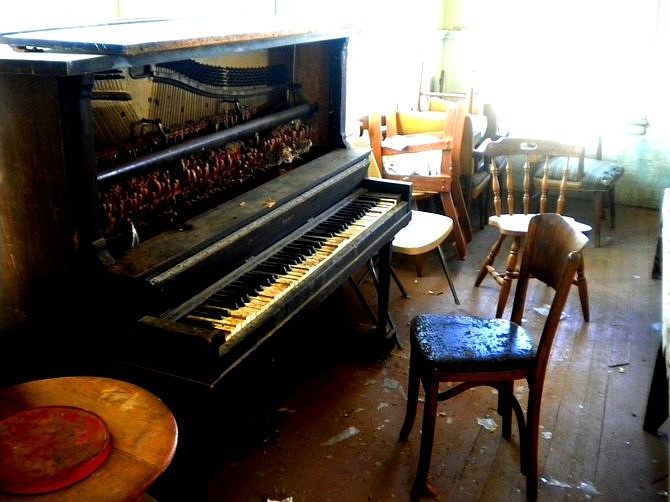
My favorite part of town was the schoolhouse. Well, both of them – the original crumbling structure and the newer build abandoned halfway through completion. A gorgeous, flaking piano (left) takes center stage in the newer schoolhouse, stuffed with innards of mouse nests and dust - it apparently appeared in Ghost Adventures, but we couldn’t get it to play at all, let alone tinkle on its own, when only a locked-off camera was watching.
There is something immediate about the schoolhouse, and the debris that has been left behind - ragged curtains drifting around empty windows, a rusting electric fan, the musty armchair sprouting springs - are relics more of a rushed evacuation than signs of slow-burning decay. The creaking swingset outside cast eerie shadows across the sand and it reminded me of the disaster zone of Chernobyl more than any ghost town I’ve seen. Fascinating contrast to the hokey, Wild-West diorama in other parts of Vulture City.
On a recent whirl through Arizona, a local man told me that they had found fresh gold at Vulture City and decided to close the mine completely rather than take their chances with thieving tourists.
I’m not sure if he was joking or not – got to love the deadpan, desert humor – but I hope it’s not true. It would be a real shame to deprive people of this rare and well-preserved glimpse into pioneering history. They just don’t make ghost towns like this anymore.


There is no denying it; I am an apocalyte. A lover of all things bleak and transient, the beauty of decay is in my blood. Find me a ghost town, a derelict asylum, an abandoned power station or even an empty barn and I’m happy.

So, on a trip through Arizona to visit the Grand Canyon and trippy little Sedona, it was inevitable that Vulture City would catch my eye. A few miles west of Wickenburg, the now-defunct gold mine was established in the 1860s (by Henry Wickenburg himself) and, despite flourishing into a thriving settlement, closed down less than a century later after national focus shifted to the war effort.
Now, the mine and town lie barren at the mercy of the harsh, desert winds. And for just a $10 entry fee, we were given a hand-drawn "treasure map" and free run of the place.
A small disclaimer: I was lucky enough to visit Vulture Mine before new ownership took over and restricted visitors to guided tours, which is an absolute shame. Surely the allure of any ghost town is the chance to step away from the crowds and imagine you’re the only person exploring the lonely structures, a last, surviving observer of the past? Such opinions aside, Vulture City is still worth a stop (but best check the opening times first).
The remains of the town and mine are surprisingly well-preserved, and it's an easy mile-or-so wander to see everything.

Mining offices and buildings are fenced-off to protect the crumbling history, but there are enough open areas to explore firsthand. The rickety wooden mine headframe (left) towers like a prehistoric rollercoaster over a shabby blacksmith shop decorated with tools and disembodied miner’s boots. The tin sidings gleamed with bullet holes. A suspended plank of wood twirled and creaked eerily in the breeze. A previous explorer had scrawled "redrum" on a dusty window pane, but even creepier were the suspended grubby long-johns, swaying from a hook like a ghostly miner warning us away. Even on a blistering bright day, something about Vulture City brings out the chills.
To the ghost town enthusiast, the interesting combination of history and setup can feel staged in places – rusting bathtubs, a high-heeled shoe standing proud in the window of the cathouse, sewing machines and antique furniture posed in flaking doorways – but most of it has a genuine feel.
The kitchen built to feed the miners stills stands, with shelves of mismatched crockery and peeling cans of food and coffee. The buildings do not look reconstructed or patched up, they're original pieces of a short-lived yet crucial part of American history (even if they do look as if they would fall over at any moment).
The added personal touches may seem phony in places, but they do give an authentic sense of the people who lived, worked and died here.

Another must-see is the mill where heavy chunks of gold ore were crushed through a minefield of rusting jaws and wheels to release the precious commodity. Iron oxide bleeds through the bolts and cogs, giving them the gory appearance of ancient mangled insides. The eviscerated electronics and pressure gauges make for truly great photos, and we clambered over the machinery to get the best angled shots.
The adjacent storage room of discarded cyanide containers was especially photogenic - presumably the noxious poison was used to leach gold from the ore – with upturned barrels oozing suspicious white residue like a scene from an ecological disaster movie. Probably best to wash our hands before leaving town.
A particularly sinister point of interest is the Hanging Tree. Eighteen men accused of theft were allegedly executed from the low-hanging branches (a nasty way of prolonging the torture of death, with a reprieve being just a tiptoe out of reach).
We ate our Subway sandwiches under the boughs, and I have to admit, there was nothing even remotely spooky about the experience. Perhaps it was the glorious sunshine or chatter of cheeky birds in the trees that lightened the menacing surroundings, but it felt peaceful compared to the industrial malevolence of the mill.

My favorite part of town was the schoolhouse. Well, both of them – the original crumbling structure and the newer build abandoned halfway through completion. A gorgeous, flaking piano (left) takes center stage in the newer schoolhouse, stuffed with innards of mouse nests and dust - it apparently appeared in Ghost Adventures, but we couldn’t get it to play at all, let alone tinkle on its own, when only a locked-off camera was watching.
There is something immediate about the schoolhouse, and the debris that has been left behind - ragged curtains drifting around empty windows, a rusting electric fan, the musty armchair sprouting springs - are relics more of a rushed evacuation than signs of slow-burning decay. The creaking swingset outside cast eerie shadows across the sand and it reminded me of the disaster zone of Chernobyl more than any ghost town I’ve seen. Fascinating contrast to the hokey, Wild-West diorama in other parts of Vulture City.
On a recent whirl through Arizona, a local man told me that they had found fresh gold at Vulture City and decided to close the mine completely rather than take their chances with thieving tourists.
I’m not sure if he was joking or not – got to love the deadpan, desert humor – but I hope it’s not true. It would be a real shame to deprive people of this rare and well-preserved glimpse into pioneering history. They just don’t make ghost towns like this anymore.
Comments